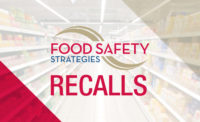By definition, forensic environmental health deals with the relation and application of facts in sanitary science and public health to legal problems. In every foodborne illness in which damages are sought though the initiation of a lawsuit, there are several questions that always need to be answered: who, what, when, where, why, and most importantly, how? The answers are provided by a panel of experts who, according to the established Rules of Evidence, “assist the trier of fact” through their “scientific, technical, or other specialized knowledge.” If the opinions are not based on reliable methodology they may not be of benefit to the trier of the case and in fact, may be disqualified. So, if any component is missing or unreliable, the case will not stand on its own merit.
The question of “who?” comes to us from the attorney through the complaint and initiation of a lawsuit; this can encompass one person or a whole host of individuals along with impressions and details of the events that led to the foodborne misadventure along with an interpretation of the law. The “what?” is answered by the physician who makes a medical diagnosis of the foodborne illness with corroboration by laboratory confirmation. There is generally a detailed description of the illness, its severity and outcome. The laboratory work provides us with the identity of the responsible microbes, and if we are particularly lucky, the laboratory identification will also include species and strains. The epidemiologist identifies the food or foods involved and sorts out the all-important stochastic components of the food misadventure. Without this time component and cascade of events, the misadventure is amiss. The epidemiologist’s analysis confirms the “what?” and “when?”, and hopefully provides us with “where?”. More importantly, it narrows the search and gives a scientific definition to the case and offers clues to the scope of the possible problem.
The last questions to be answered belong to the sanitarian. It is the sanitarian’s job is to find the “how?” by doing a thorough a comprehensive risk analysis, and with any luck, answer the final question: “why?”. In other words, the sanitarian defines the series of events that led to the foodborne illness and more importantly, why it happened. Our work can also prove the converse or the possibility of the absence of an event. This entire compilation of information then goes back to the attorneys who put it in some cogent form to build a solid argument for either the plaintiff or defendant. The legal profession uses the same information for both sides of the debate, science being what it is.
But unlike the hard sciences such as mathematics, physics and chemistry, environmental health—and particularly that specialty of our profession that deals with food safety—uses the applied sciences that draw from many disciplines. The relationship and application of facts of a foodborne illness are not always in a straight line, but they are logical. More often than not, causal relationships are convoluted, if not altogether elusive. As such, absolute proofs and single risk factors of foodborne illnesses are few and far between. Rarely can any food-related misadventure be described in a simple declarative sentence without qualification. It takes the sanitarian’s collective knowledge, skills and attributes to make sense out of the volumes of subjective opinions and factual materials gathered for the question “how?” in answering the ultimate question: “why?” I say this, having worked these past two-score years on numerous cases for both sides of the aisle.
To be clear, the legal profession is not always in concert with good science. It is the lawyers’ job to either win a sizeable settlement or minimize damage for their clients, depending on whose side they are working. To watch the drama unfold in a hearing, court or at a deposition only serves to baffle the rest of us that a reasonable decision is reached. But somehow it is, and all the arguments, legal strategies, histrionics and courtroom posturing result in a fair and equitable decision (most of the time); whether based on law, science or economics. To truly appreciate the complexity of even the simplest and most straightforward foodborne illness cases, as well as learn about myriad questions that they raise, I refer you to an excellent, recently published (2007) book that is available through the American Society for Microbiology Press. Its author is Phyllis Entis and the book is entitled “Food Safety: Old Habits, New Perspectives.” It is magnificently researched and well worth reading by all of us who are professionals in food safety, who want to know more about the “how” and “why.”
Regardless of the outcomes of lawsuits resulting from foodborne illnesses, I can think of no retail food establishment that purposely sets out to harm their customers or effectively wants to kill their business or bring irreparable financial harm to themselves. Although, at times I have to wonder at the poor judgment exercised and risks taken by some of the businesses with which I have dealt. Yet, in our applied science, there are certain conditions that seem to reemerge as the bellwether to most events. I put these into several categories: adherence to basic regulations, environmental influences and professional competency.
Adherence to Regulations
Before any on-site investigation is conducted (hopefully, before any depositions are taken and before making any pronouncement of professional judgment, pro or con), a review of an establishment’s past inspection records will provide some insights into its operation. Most, if not all retail food establishments that have been in business for any length of time have some track record of conforming, or not conforming as the case may be, to regulations. I am not that naive to think that an inspection report actually points to any of the major causal factors of foodborne illness, but it does provide some direction to the course of the subsequent investigation.
The workloads borne by most local sanitarians leave little time to conduct a truly comprehensive inspection, much less a risk-based food safety audit of a food establishment. The regulatory inspections however do provide a clue through “wall, floor and ceiling” cleanliness evaluations and occasionally a citation for temperature abuse, contaminated equipment and the presence of vermin. Generally, the lower the score or the more deficiencies cited in even the most cursory and subjective inspections, the greater are the chances of a questionable food safety commitment by the operator. Since form follows function, an establishment that is unsanitary, may also be suspect of poor personal hygiene practices, inadequate cooking temperatures, incidents of cross contamination and purchasing foods from unsafe sources. The regulatory inspection guides us to those areas in which we need to focus our attention during our site visit. The current Food Code, sampling and instrumentation, and, the information from the attorney, epidemiologist and physician serve as our basic tools. Observing the facility in full operation and mapping personnel and materiel movement, including handwashing, completes the inspection picture.
Environmental Influences
The second important component to an environmental health forensic investigation of a foodborne misadventure is a comprehensive plan review of the facility and a Hazard Analysis and Critical Control Point (HACCP) evaluation of its operations. Basically, the plan review serves to answer the question: Can the facilities support the menu, and can the foods on the menu be handled and prepared safely? We need to learn of the utilities that support the operation such as water and plumbing, sewage, electrical service, ventilation, solid waste handling and physical structure, both inside and out. We need to discern traffic patterns in the kitchen; adequacy of all equipment including its size, operation and use; cooking, storage and scullery capabilities; available facilities for personal hygiene and basic adequacy of space for the prevention of temperature abuse and cross-contamination. Finally, we need to learn of suppliers, delivery schedules and storage capabilities.
The plan review process provides the answers to all of these concerns (and more) quite nicely. It will identify most, if not all questionable components in the environment that can influence the risk of foodborne disease transmission. As useful as the plan review is to ferret out problem areas, it is likewise valuable in minimizing future risks. Unfortunately, too few health departments have the time, funding or resources to perform comprehensive plan reviews for most, if not all the establishments in their jurisdiction. I simply had to interject this last editorial comment.
A full HACCP evaluation, or at least a Street HACCP audit in the absence of a formal comprehensive program will generally identify those operational components that significantly contribute to temperature abuse or questionable handling practices. When the critical control points of the foods in question are identified and overlaid onto the plan review, the answer to “how?” becomes clear.
Professional Competency
The final “why?” can be directly attributed to the establishment’s operations, including its administrative and work policies regarding food safety. Needless to say, this is the most difficult question to answer because it is the most difficult to directly observe and quantify. However, a 2006 collaborative study conducted by the University of Minnesota, the U.S. Centers for Disease Control and Prevention (CDC) and the Tennessee Department of Health provided a systematic approach that identified differences between outbreak and non-outbreak restaurants.[1] The authors identified handling of food by an infected person or carrier and bare-hand contact with food as the most commonly identified contributing factor. But what is really significant about their findings are the number of factors for which an odds-ratio was established and their direct relation to outbreaks. The list is indeed brief and the confidence intervals are significant; particularly when it is compared to the aforementioned commonly identified contributing factors. It includes the following:
1. Restaurant has certified kitchen manager
2. Manager is aware of HACCP
3. Restaurant offers sick leave benefits for food workers
4. Food workers are required to report illness to a manager
5. Ill food workers are restricted from working
These conclusions supported by their statistical significance complete the environmental health forensic package. Although anecdotal, I would like to add yet another: Education and staff training; specifically, the frequency of continuing education of the management and tool box training or its equivalent of the staff.
Working with this model over the years, several preconceived ideas about foodborne disease outbreaks went by way of the television program Mythbusters, common thinking aside. First, I’ve learned that a solitary case can indeed occur (always remember the fourth standard deviation from the mean) particularly in light of a thorough investigation with numerous attending risk factors. Secondly, no foodborne outbreak or its absence can successfully be established without going through the exercise of evaluating the regulation, environment and professional factors of an operation. No argument has ever been won without transitioning from the subjective to the objective. As an example, this means defining how clean is clean and validating all observations by some established protocol. And finally, expert conclusions must be based on sound and defensible methodologies. It would serve each of us in food safety if we learned these lessons well.
Forensic sanitarian Robert W. Powitz, Ph.D., MPH, RS, CFSP, is principal consultant and technical director of Old Saybrook, CT-based R.W. Powitz & Associates, a professional corporation of forensic sanitarians who specialize in environmental and public health litigation support services to law firms, insurance companies, governmental agencies and industry. For more than 12 years, he was the Director of Environmental Health and Safety for Wayne State University in Detroit, MI, where he continues to hold the academic rank of adjunct professor in the College of Engineering. He also served as Director of Biological Safety and Environment for the U.S. Department of Agriculture at the Plum Island Animal Disease Center at Greenport, NY. Among his honors, Powitz was the recipient of the NSF/NEHA Walter F. Snyder Award for achievement in attaining environmental quality, and the AAS Davis Calvin Wagner Award for excellence as a sanitarian and advancing public health practice. He is the first to hold the title of Diplomate Laureate in the American Academy of Sanitarians, and also is a Diplomate in the American Academy of Certified Consultants and Experts and with the American Board of Forensic Engineering and Technology.
Dr. Powitz welcomes reader questions and queries for discussion in upcoming columns, and feedback or suggestions for topics you’d like to see covered can be sent to him directly at powitz@sanitarian.com or through his website at www.sanitarian.com.
Reference
1. Hedberg, C.W., S.J. Smith, E. Kirkland, V. Radke, T.F. Jones, C.A. Selman and the EHS-Net Working Group. 2006. Systematic environmental evaluations to identify food safety differences between outbreak and nonoutbreak restaurants. Journal of Food Protection 69(11):2697-2702.




